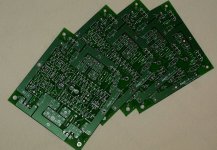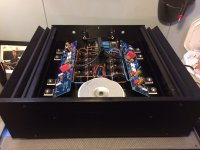use 2sj78s instead to 9610s?
hi,
i found 2sj78/2sk215 at local store
in datasheets 2sj78 better than 9610
2sj78; 120 pf input cap.
irf9610; 170 pf input cap.
can i use 2sj78s for first gain stage?
2sj78 datasheet;
http://documentation.renesas.com/doc/products/transistor/rej03g0122_2sj76ds.pdf
(i am using now 2sj74 pair in voltage gain stage - JX mod.. 2x18 v supply after big cap. total 5.6A bias, 8 output fets are matched IRFP240s)
hi,
i found 2sj78/2sk215 at local store
in datasheets 2sj78 better than 9610
2sj78; 120 pf input cap.
irf9610; 170 pf input cap.
can i use 2sj78s for first gain stage?
2sj78 datasheet;
http://documentation.renesas.com/doc/products/transistor/rej03g0122_2sj76ds.pdf
(i am using now 2sj74 pair in voltage gain stage - JX mod.. 2x18 v supply after big cap. total 5.6A bias, 8 output fets are matched IRFP240s)
I'm still reading about this amp but I believe you can use those chips for the front end. This design is over ten years old and I think it has lots of potential for update. With newer precision parts and a cap multiplier, I suspect these amps can be made to perform throughout their bandwidth with 10 ppm distortion. How many people out there have built these amps and have ripple hum? Am I correct to estimate there are 1000 of these amps out there?
Hello,
I offer the PCB Aleph-X for sale.
I need to have for the four Boards 36€ +shipping cost.
look at picture
Bye Alex
Hello. Did you still have the PCB for sale ? I will be interest. Shipping is to France.
Please let me know or contact me in my e-mail.
Regards, Victor
Hi Leikis,
That's a pretty cool case. Looks very much like a first watt one.
I like this chassis very good, absoluteley worth the money.
You can find it on Ebay !
Hello Leikis,
Can you tell us how hot are the heatsinks in you amp (if you have a temperature measurement device)? If not, could you still put your hand on the heatsink for like 5-10 seconds? Thanks!
Because of the small hetasink i have to lover the bias to around 320mV, then i reach 54-55c i a room with 25-26c. The transistors is around 60-62c.
Has anyone ever measured their Aleph-X THD+N distortion numbers? The commercial XA100 claims <300uV of noise over the entire bandwidth. That is only about -70dB which is not terribly impressive. I understand class A means zero crossover distortion but what can we do to get this to a -90dB (ie:30uV) noise floor?
What advantage does a 4x3 configuration have over the original 2x2? I would prefer to get the Siemans from a pair of closely matched IRFP140/150s than a set of 6 IRFP240's. You'll have an easier time getting a set, they're less likely to oscillate and you can bias them harder which will make them more linear. From my point of view, more chips mean more headache.Zen Mod said:do not go with less of 3 pairs per side , so having 3 in each quadrant , for sum of 12 per channel
Finaly done, just some fine adjustments left.
But cant realy find ut what the LTP Bias pot does ? Any sugsetion what to do ?
400VA 2x18v toroid. 80000uF for each channel using Elna 10000uF 80v.
Hi,
I suppose this sets the absolute DC at the outputs. VR2 in the original Hifizen schematic.
William
What advantage does a 4x3 configuration have over the original 2x2? I would prefer to get the Siemans from a pair of closely matched IRFP140/150s than a set of 6 IRFP240's. You'll have an easier time getting a set, they're less likely to oscillate and you can bias them harder which will make them more linear. From my point of view, more chips mean more headache.
deeper means more muscle for heavier load
remember that amp is bridged , so doubled Rout comparing to "regular" amps
There is a practical heat limit to how deep you can go. With 22V rails, you will not likely be able to exceed 1A of bias per FET with a build of twelve which indicates using a source resistance of 0.5R. The equivalent depth can be achieved with 0.017R on a classic build of two pair. Yes the junction temperature will likely reach 115 degrees (more than double) in a warm room but that is still 35 degrees under the S.O.A. and parts like the IRFP150 offer an additional 25 degrees of safety margin. Additionally, fewer FETs mean lower Ciss, an arguably better layout and a very much simpler build. For me, I don't see the allure of using more than 4 FETs per channel.
- Home
- Amplifiers
- Pass Labs
- Aleph-X builder's thread.


